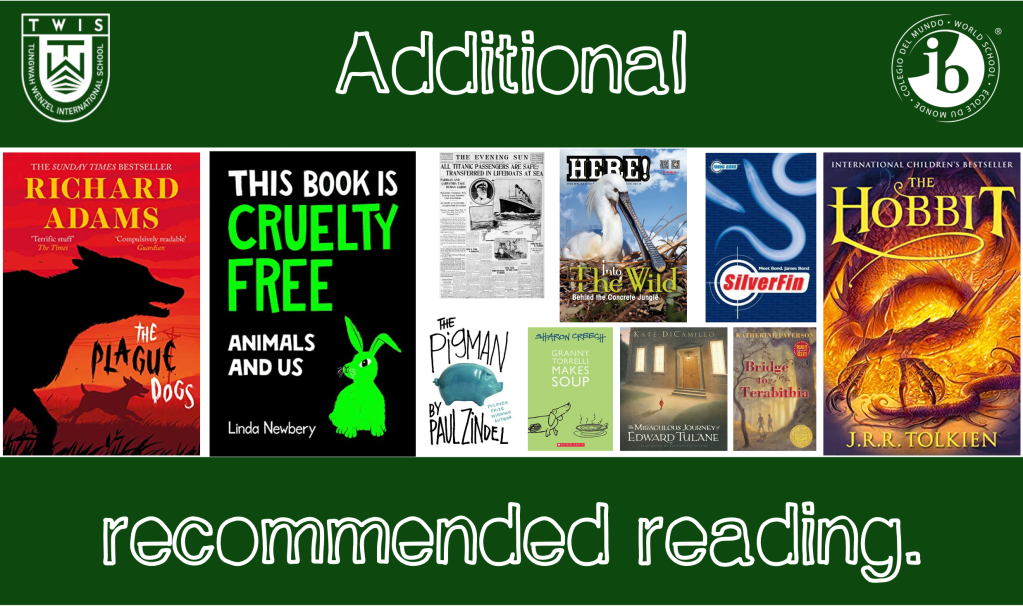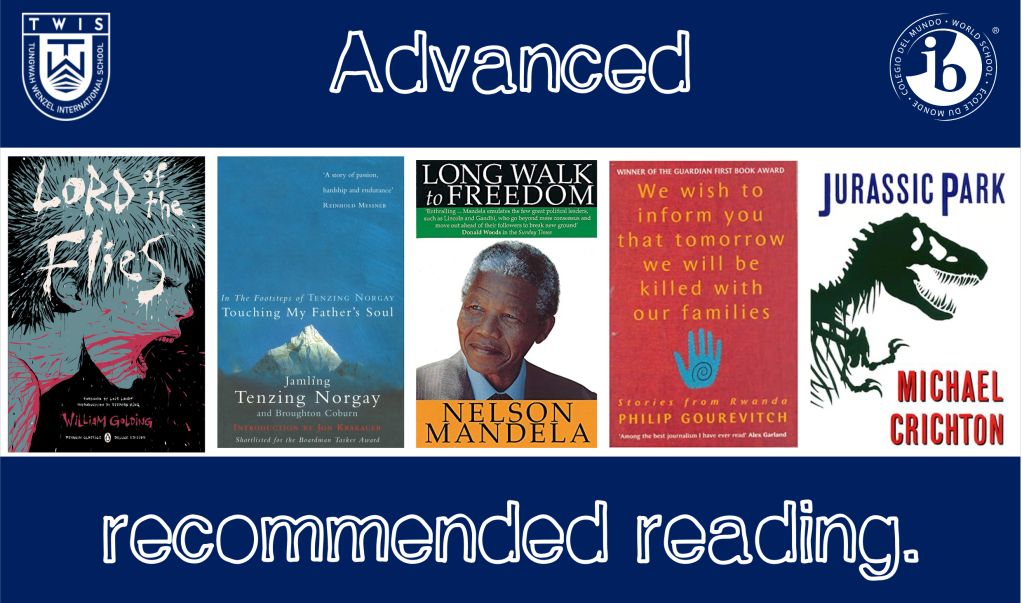Dear readers,
“I have a passion for teaching kids to become readers, to become comfortable with a book, not daunted. Books shouldn’t be daunting, they should be funny, exciting and wonderful; and learning to be a reader gives a terrific advantage.” – Roald Dahl
The below is a huge draft that will be edited and chopped probably into less than 150 words, or maybe just a handful of sugar, or likely whichever earns me the most coffee cups. It all started when Miss Hannah in marketing asked me to create something for social media in relation to holiday reading. I immediately wanted to share Roald Dahl. Then, I thought about international mindedness, books with messages and genres that leave your heart tickling. Of course, there are many mainstream examples and some are quite well-known, but that’s the magic of a good book – it cannot stay shut! It fails to remain quietly shut in a dark corner of a room. Books cry out for attention. They’re living breathing monsters that grip you, hug you and leave sloppy kisses on your cheeks. So, that’s the introduction to the opener below.
“I can’t imagine a man really enjoying a book and reading it only once.” – C.S. Lewis
Do you remember the first time you opened a book and it truly grabbed your attention? Perhaps that text took you away to a whole new world. Maybe that story whisked you off on a never ending story. Certainly the protagonist had your attention. You were hooked! You find yourself nose-deep in the book, living and feeling the words! Breathing in a rollercoaster ride or feeling the love from the rows and rows of the word beneath. Importantly, age groupings are never always accurate. Students read and write at various levels of ability across age and year groups. It’s important to differentiate to an appropriate reading level. It is worth noting that opening new books may not prove too challenging, however, it can always awaken a part of a new imagination.
“There are many little ways to enlarge your child’s world. Love of books is the best of all.” – Jacqueline Kennedy Onassis

Whether you’re an avid reader or a book guru, books such as The Animals of Farthing Wood (Colin Dann) can stick with you for life. Reading about characters such as Tintin and adventures such as The Lord of The Rings can shape our expectations of movies or provide us with hours of conversations amongst thinkers and friends. As we reflect in life, we’re often granted opportunities to communicate our recommendations. Here are a few books to get you going.
Emerging readers: Kindergarten & PYP levels 1-2 / grades 1-2 / UK nursery school or years 1-2 (5-7 years)
Books at this level should be packed full of sight words, colour and invention. A trio of examples shall follow. The Reverend W. Awdry wrote Thomas the Tank Engine and friends. His 26 stories were aimed at his child Christopher. It must have worked because later on, son followed father, adding a further collection to the series! Eric Carle was a colourful writer, creating a list of books as long as my arms and legs (which are very long indeed). The Very Hungry Caterpillar is an iconic place to start reading his works: “One sunny Sunday, the caterpillar was hatched out of a tiny egg. He was very hungry.” Janet and Allan Ahlberg are no strangers to children’s fiction. This married couple worked together for over two decades. Funny Bones, Mr Biff the Boxer, and Kicking a Ball.
“Oh, magic hour, when a child first knows she can read printed words!” – Betty Smith
At these ages students are now working out how to segment words using phonics and recognising an increasing number of sight words. They’re differentiating homonyms whilst learning to love books. Read daily and often with your kids now and they should develop at their fastest! To that mind look up the following books: All Join In (Quentin Blake – one of the greatest and most distinctive illustrators of all time); Peace at Last (Jill Murphy); The Runaway Wok (Ying Chang Compestine); Mr Wolf’s Pancakes (Jan Fearnley); Owl Babies (Martin Waddell & Patrick Benson); Suddenly (Colin McNaughton); Grumpy Frog (Ed Vere); Oi Frog! (Kes Gray & Jim Field); The Squirrels Who Squabbled (Rachel Bright & Jim Field); Flotsam (David Wiesner); Guess How Much I Love You? (Sam McBratney); Slow Loris (Alexis Deacon); I Want My Potty! (Tony Ross); Dear Zoo (Rod Campbell); Meg and Mog (Helen Nichol and Jan Pienkowski) and so many more… (further inspiration can be sourced here).
PYP 3-5 / grade 3-5 / UK years 3-5 (7-9 years)
Flat Stanley, penned by Jeff Brown, tells the story of a boy squashed by a bulletin board. His newfound flatness allows him to slip under doors like a piece of mail. He can even fly like a kite! This story series has been around for more than fifty years. The authors six original stories have inspired a catalogue of stories by other authors. There is also the Flat Stanley Project which brings together an awful lot of people around the world. Jackie Chan approves of it.
“Never trust anyone who has not brought a book with them.” – Lemony Snicket
Anything from the collections of Dr Seuss, A.A. Milne (Winnie the Pooh), Astrid Lindgren (Pippi Longstocking) and Roald Dahl should capture attention at this age. René Goscinny and Albert Uderzo‘s Asterix the Gaul series can open up new frames as to how a story can appear. I would recommend this following group too. The Nothing to See Here Hotel (Steven Butler); The Bee is not Afraid of Me (Fran Long & Isabel Galleymore); King Kong (Anthony Browne); Dilly the Dinosaur (Tony Bradman); The Diary of a Cat Killer (Anne Fine); Mrs Cockle’s Cat (Philippa Pearce); The Owl Who Was Afraid of the Dark (Jill Tomlinson); Where The Wild Things Are (Maurice Sendak); Mr Majeika (Humphrey Carpenter); How to Train Your Dragon (Cressida Cowell); The Sheep-Pig (Dick King Smith’s book was made into the movie Babe); Charlotte’s Web (E.B. White); The Iron Man (Ted Hughes) Cliffhanger (Jaqueline Wilson); Peter in Peril (Helen Bate); Coming to England (Floella Benjamin) and other great books for PYP3, PYP4 and PYP5.

“The more that you read, the more things you will know. The more that you learn, the more places you’ll go.” – Dr. Seuss
MYP 1/2 / grades 6-7 / UK years 5-6 (9-11 years)
“The reading of all good books is like conversation with the finest (people) of the past centuries.” – Descartes
After developing imagination and experiencing adventure, books tend to favour realistic fiction and serious topics for older students. At this age, books open doors into many new worlds and offer insights into many other cultures. Encyclopedia-style texts lure in the curious and student inquirers. Hard-hitting and dark stories sit between classics and familiar friends of the literature world. Look up: The Boy At the Back of The Class (Onjali Rauf); Illegal (Eoin Colfer – think Artemis Fowl); Abomination (Robert Swindells); The Hobbit (J.R.R. Tolkien); What Katy Did (Susan Coolidge); The Chronicles of Narnia (C.S. Lewis); The Borrowers (Mary Norton); Silverfin (Charlie Higson’s young James Bond series) and so on.
“So please, oh please, we beg, we pray, go throw your TV set away, and in its place, you can install a lovely bookshelf on the wall.” – Roald Dahl

MYP 3/4 / grades 8-9 / UK years 7-8 (11-13 years)
“I find television very educating. Every time somebody turns on the set, I go into the other room and read a book.” – Groucho Marx
Recently the language and literature class tackled Bridge to Terabithia by China-born Katherine Paterson. This novel became a Disney-adaptation. Few students favoured the movie over the book. Books have often been adapted for the silver screen, the television or the stage. A great checklist to read and then watch can include the following: Madame Doubtfire (Anne Fine); The Outsiders (S.E. Hinton); The Curious Incident of the Dog in the Night-time (Mark Haddon); The Day of the Triffids (John Wyndham); The Hound of the Baskervilles (Arthur Conan Doyle’s Sherlock Holmes); The Plague Dogs (Richard Adams); The Woman in Black (Susan Hill); Watership Down (Richard Adams); and The Giver (Lois Lowry).
“Reading is essential for those who seek to rise above the ordinary.” – Jim Rohn
MYP 5/DP / grades 10+ / UK years 9+ (13+ years)
“A reader lives a thousand lives before he dies . . . The man who never reads lives only one.” – George R.R. Martin
At this age level, the vocabulary is expanding with new words dropping down like rain. Students are better armed to scaffold and learn these familiar unfamiliar phrases and terms. Using their decoding techniques they can swiftly move through lengthy text. The classic The Time Machine by H.G. Wells, Khaled Hosseini’s The Kite Runner and Maus by Art Spiegelman are fine examples of texts that would sit well on a student’s bookshelf. Students who watch movies such as Dune and Jurassic Park, should at this point, now be lifting the text that inspired these movies. The respected authors Frank Herbert and Michael Crichton have sizable and diverse reading catalogues suitable for those who claim to be knowledgeable. Writers and readers alike should explore diverse texts, such as: This Book is Cruelty Free (Linda Newbery); Atonement (Ian McEwan); Long Walk to Freedom (Nelson Mandela); Touching My Father’s Soul (Jamling Tenzing Norgay). I would also thoroughly recommend Paddy Clarke Ha, Ha, Ha by Roddy Doyle and William Golding’s Lord of The Flies because by now a rounded reader is a communicator of text. Just ask the students of language and literature at TWIS. Further reading suggestions can be found here and there.
“You can never get a cup of tea large enough or a book long enough to suit me.” – C.S. Lewis

Tired of heavy paper books? Do your children favour electronic devices? Try a popular e-reader like Kindle or Kobo. They may be devices that are limited, but that’s the beauty of it. Why worry about bad eyesight or distractions? There are stacks of available titles, some free and many can be read from .PDF documents. Many are portable. The anti-glare screens and lack of blue light make most devices unobtrusive to eyesight. Some even have onboard dictionary features.
Consult your librarian or find a suitable booklist, then check off or list how many books you have read! Be principled!
Many of us are traditional and favour paper because of the smells and textures, as well as the tangible aspect. We like to touch things. Make sure the next thing your son or daughter touches is one that reaches back and captures their heart. On top of that, books exercise brains, and to quote Roald Dahl, “If you are going to get anywhere in life you have to read a lot of books.” There you have it. Read it. Read it all. Read everything! I read everything. I read every little thing. That’s not true. I wish I did. I’m still working on it.
Thank you kindly for your time and reading.
Mr John